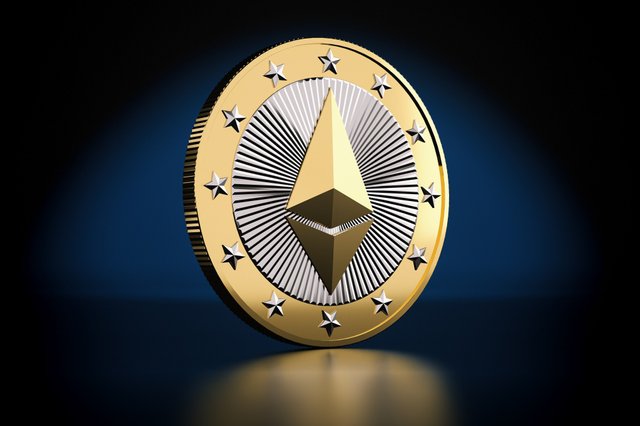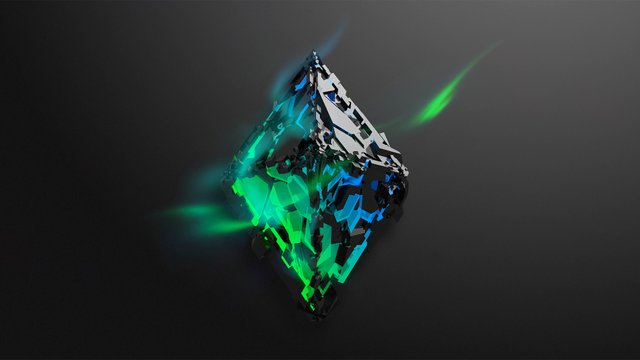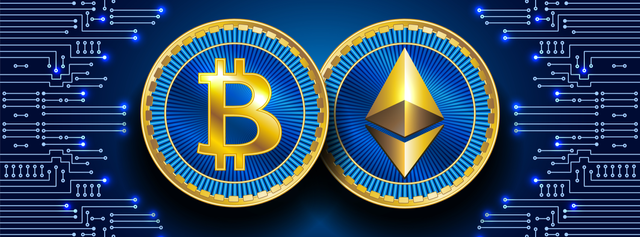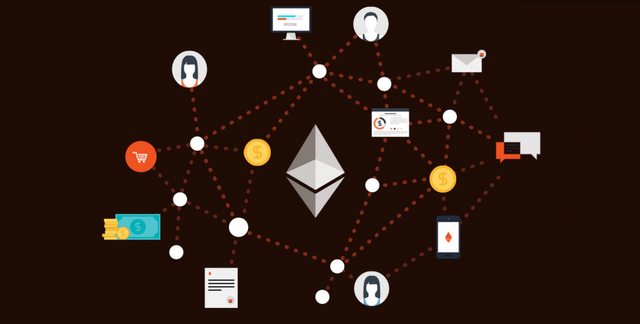
The Ethereum Project’s logo, First used in 2014
Initial release : 30 July 2015
Development status : Active
Written in : Go, C++, Rust
Operating system : Clients available
for Linux, Windows, macOS, POSIX, Raspbian
Platform : x86, AMD64, ARM
Type : Decentralized
Computing, Blockchain, Cryptocurrency
License : GPLv3, LGPLv3, MIT
Website : ethereum.org
Ethereum is an open-source, public, blockchain-based distributed computing platform and operating system featuring smart contract(scripting) functionality. It supports a modified version of Nakamotoconsensus via transaction based state transitions.
Ether is a cryptocurrency whose blockchain is created by the Ethereum stage. Ether can be exchanged amongst records and used to repay member digging hubs for calculations performed. Ethereum gives a decentralized Turing-completevirtual machine, the Ethereum Virtual Machine (EVM), which can execute contents utilizing a universal system of open hubs. "Gas", an inside exchange estimating system, is utilized to alleviate spamand dispense assets on the system.
Ethereum was proposed in late 2013 by Vitalik Buterin, a cryptocurrency specialist and software engineer. Improvement was subsidized by an online crowdsale that occurred amongst July and August 2014. The framework went live on 30 July 2015, with 11.9 million coins "premined" for the crowdsale. This records for around 13 percent of the aggregate circling supply.
In 2016, because of the fall of The DAO venture, Ethereum was part into two separate blockchains – the new separate rendition moved toward becoming Ethereum (ETH), and the first proceeded as Ethereum Classic (ETC). The estimation of the Ethereum money developed more than 13,000 percent in 2017.
Etymology
Vitalik Buterin picked the name Ethereum in the wake of perusing Wikipedia articles about components and sci-fi, when he found the name, noticing, "I instantly understood that I enjoyed it superior to the greater part of alternate choices that I had seen; I assume it was the way that sounded pleasant and it had the word 'ether', alluding to the speculative undetectable medium that penetrates the universe and enables light to movement.
History

Ethereum was at first depicted in a white paper by Vitalik Buterin, a software engineer required with Bitcoin Magazine, in late 2013 with an objective of building decentralized applications. Buterin had contended that Bitcoin required a scripting dialect for application advancement. Neglecting to pick up assention, he proposed improvement of another stage with a more broad scripting dialect.
At the season of open declaration in January 2014, the center Ethereum group was Vitalik Buterin, Mihai Alisie, Anthony Di Iorio, and Charles Hoskinson. Formal advancement of the Ethereum programming venture started in mid 2014 through a Swiss organization, Ethereum Switzerland GmbH (EthSuisse). In this manner, a Swiss non-benefit establishment, the Ethereum Foundation (Stiftung Ethereum), was made also. Advancement was financed by an online open crowdsaleduring July– August 2014, with the members purchasing the Ethereum esteem token (ether) with another computerized money, bitcoin. While there was early acclaim for the specialized advancements of Ethereum, questions were likewise raised about its security and versatility.
Enterprise Ethereum Alliance (EEA)
In March 2017, different blockchain new businesses, inquire about gatherings, and Fortune 500 organizations declared the formation of the Enterprise Ethereum Alliance (EEA) with 30 establishing individuals. By May, the philanthropic association had 116 undertaking individuals—including ConsenSys, CME Group, Cornell University's examination gathering, Toyota Research Institute, Samsung SDS, Microsoft, Intel, J. P. Morgan, Cooley LLP, Merck KGaA, DTCC, Deloitte, Accenture, Banco Santander, BNY Mellon, ING, and National Bank of Canada. By July 2017, there were more than 150 individuals in the organization together, including late increments MasterCard, Cisco Systems, and Scotiabank.
Milestones

Version Code name Release date
0 Olympic May, 2015
1 Frontier 30 July 2015
2 Homestead 14 March 2016
3 Metropolis (vByzantium) 16 October 2017
3.5 Metropolis (vConstantinople) TBA
4 Serenity TBA
Old version
Latest version
Future release
A few codenamed models of the Ethereum stage were produced by the Foundation, as a feature of their Proof-of-Concept arrangement, preceding the official dispatch of the Frontier organize. "Olympic" was the remainder of these models, and open beta pre-discharge. The Olympic system gave clients a bug abundance of 25,000 ether for stretch testing the breaking points of the Ethereum blockchain. "Outskirts" denoted the conditional trial arrival of the Ethereum stage in July 2015.
"Residence" was the first to be viewed as steady. It incorporates upgrades to exchange handling, gas evaluating, and security. Since the underlying dispatch, Ethereum has experienced a few arranged convention overhauls, which are imperative changes influencing the basic usefulness as well as impetus structures of the stage.
"City Part 1: Byzantium" was propelled on October 16, 2017, and included changes to diminish the many-sided quality of the EVM and give greater adaptability to keen contract designers. Byzantium additionally includes bolsters for zk-SNARKs (from Zcash); with the principal zk-SNARK exchange happening on testnet on September 19, 2017.
There are no less than two other convention redesigns arranged later on: "City Part 2: Constantinople" will establish the frameworks for the progress to evidence of-stake (Casper), influence changes in accordance with the trouble to time bomb, and include bolster for account reflection.
"Peacefulness" ought to incorporate a key change to Ethereum's accord calculation to empower a fundamental progress from equipment mining (evidence of-work) to virtual mining (verification of-stake). Changes to versatility, particularly sharding, are additionally said to be a key goal on the improvement guide.
The DAO event
In 2016 a decentralized self-ruling association called The DAO, an arrangement of brilliant contracts created on the stage, raised a record US$150 million out of a crowdsale to finance the undertaking. The DAO was abused in June when US$50 million in ether were asserted by a mysterious element. The occasion started an open deliberation in the crypto-group about whether Ethereum ought to play out an antagonistic "hard fork" to reappropriate the influenced reserves. Because of the debate, the system split in two. Ethereum (the subject of this article) proceeded on the forked blockchain, while Ethereum Classic proceeded on the first blockchain. The hard fork made a competition between the two systems.
After the hard fork identified with The DAO, Ethereum in this way forked twice in the final quarter of 2016 to manage different assaults. Before the finish of November 2016, Ethereum had expanded its DDoS assurance, de-enlarged the blockchain, and frustrated further spam assaults by programmers.
Ether
Denominations
Symbol Ξ
Ticker symbol ETH
Subunits
10 −9 Gwei
10 −18 Wei, after cryptocurrency pionneer Wei Dai
Coins Balances from accounts to be debited/credited, in
Wei, non-UTXO scheme
Ledger
Timestamping scheme
Proof-of-work
Ethash
Hash function
Keccak
Issuance Block and Uncle/Ommer reward
Block reward 3 ETH (non-deterministic)
Block time 14-15 seconds on average
Block explorer etherscan.io
Circulating supply Ξ98,316,894 (as of 20 March 2018)
Valuation
Exchange rate
US$563.13 (as of 20 March 2018)
Market cap
US$55.37 billion (as of 20 March 2018)
Ether is a basic cryptocurrency for activity of Ethereum, which in this manner gives an open circulated record to exchanges. It is utilized to pay for gas, a unit of calculation utilized as a part of exchanges and other state advances. Mistakingly, this cash is additionally alluded to as Ethereum. It is recorded under the code ETH and exchanged on cryptocurrency trades, and the Greek capitalized Xi character (Ξ) is by and large utilized for its cash image. It is additionally used to pay for exchange charges and computational administrations on the Ethereum arrange.
Characteristics

Further information: Cryptocurrency
Likewise with different cryptocurrencies, the legitimacy of every ether is given by a blockchain, which is a persistently developing rundown of records, called pieces, which are connected and secured utilizing cryptography. By plan, the blockchain is intrinsically impervious to adjustment of the information. It is an open, circulated record that records exchanges between two gatherings proficiently and in an obvious and changeless way. Not at all like Bitcoin, Ethereum works utilizing records and equalizations in a way called state advances. This does not depend upon unspent exchange yields (UTXOs). State indicates the present adjusts of all records and additional information. State isn't put away on the blockchain, it is put away in a different Merkle Patricia tree. A cryptocurrency wallet stores the general population and private "keys" or "locations" which can be utilized to get or spend Ether. These can be created through BIP 39 style memory aides for a BIP 32 "HD Wallet". In Ethereum, this is superfluous as it doesn't work in an UTXO conspire. With the private key, it is conceivable to write in the blockchain, successfully making an ether exchange. To send ether to a record, you require the general population key of that record. Ether accounts are pseudonymous in that they are not connected to singular people, but instead to at least one particular tends to Owners can store these addresses in programming, on paper and potentially in memory ("mind wallet").
Addresses
Ethereum addresses are made out of the prefix "0x", a typical identifier for hexadecimal, linked with the furthest right 20 bytes of the Keccak-256 hash (enormous endian) of the ECDSA open key. In hexadecimal, 2 digits speaks to a byte, which means addresses contain 40 hexadecimal digits. One illustration is 0xb794F5eA0ba39494cE839613fffBA74279579268, the Poloniex ColdWallet. Contract addresses are in a similar arrangement, in any case they are controlled by sender and creation exchange nonce. Client accounts are vague from contract accounts given just an address for each and no blockchain information. Any legitimate Keccak-256 hash put into the depicted configuration is substantial, regardless of whether it doesn't compare to a record with a private key or an agreement. This is not at all like Bitcoin, which utilizes base58check to guarantee that locations are appropriately written.
Comparison with bitcoin

Ether is different from Bitcoin (the cryptocurrency with the largest market capitalization as of January 2018) in several aspects:
• Its block time is 14 to 15 seconds, compared with 10 minutes for bitcoin.
• Mining of ether generates new coins at a usually consistent rate, occasionally changing during hard forks, while for bitcoin the rate halves every 4 years.
• For proof-of-work, it uses the Ethash algorithm which reduces the advantage of specialized ASICs in mining.
• Transaction fees differ by computational complexity, bandwidth use and storage needs (in a system known as gas), while bitcoin transactions compete by means of transaction size, in bytes.
• Ethereum gas units each have a price that can be specified in a transaction. This is typically measured in Gwei. Bitcoin transactions usually have fees specified in satoshis per byte.
• Transaction fees are generally considerably lower for ether than for Bitcoin. In December 2017, the median transaction fee for ether corresponded to $0.33, while for bitcoin it corresponded to $23.
• Ethereum uses an account system where values in Wei are debited from accounts and credited to another, as opposed to Bitcoin's UTXO system, which is more analogous to spending cash and receiving change in return. Both systems have their pros and cons; in terms of storage space, complexity, and security/anonymity.
• Ethereum is planned to transfer to full Proof-of-Stake.
Supply
Cryptocurrency market capitalizationsas of 27 January 2018, in billions of US dollars.
The total supply of ether was Ξ98 million as of January 2018. In 2017, mining generated 9.2 million new ether, corresponding to a 10% increase in its total supply. Casper FFG and CBC are expected to reduce the inflation rate to between 0.5% to 2% There is no currently implemented hard cap on the total supply of ETH, but it is expected to end at a certain point, and become deflationary.
Markets and stores
Ether can be traded by regular currency brokers, cryptocurrency exchanges, as well as many online cryptocurrency wallets. As of January 2018, at least 150 stores accept ether.
Platform

Virtual Machine
The Ethereum Virtual Machine (EVM) is the runtime condition for shrewd contracts in Ethereum. It is a 256-piece enlist stack, intended to run a similar code precisely as proposed. It is the basic agreement component for Ethereum. The formal meaning of the EVM is indicated in the Ethereum Yellow Paper. It is sandboxed and furthermore totally detached from the system, filesystem or different procedures of the host PC framework. Each Ethereum hub in the system runs an EVM usage and executes similar directions. In February 1, 2018, there were 27,500 hubs in the principle Ethereum organize. Ethereum Virtual Machines have been executed in C++, Go, Haskell, Java, JavaScript, Python, Ruby, Rust, and WebAssembly (as of now being worked on). The Ethereum-enhanced WebAssembly (named "e-WASM") is required to end up a noteworthy segment of the "Internet 3.0", a World Wide Webwhere clients connect with brilliant contracts through a program.
Smart contracts
Ethereum's shrewd contracts depend on various programming languages, which designers use to program their own functionalities. Brilliant contracts are abnormal state programming reflections that are aggregated down to EVM bytecodeand sent to the Ethereum blockchain for execution. They can be composed in Solidity (a dialect library with similitudes to C and JavaScript), Serpent (like Python, yet censured), LLL (a low-level Lisp-like dialect), and Mutan (Go-based, yet deplored). There is additionally an exploration situated dialect a work in progress called Viper (a specifically Python-determined decidable dialect).
Keen contracts can be open, which opens up the likelihood to demonstrate usefulness, e.g. independent provably faircasinos.
One issue identified with utilizing keen contracts on an open blockchain is that bugs, including security openings, are obvious to everything except can't be settled rapidly. One case of this is the 17 June 2016 assault on The DAO, which couldn't be immediately halted or switched.
There is continuous research on the best way to utilize formal confirmation to express and demonstrate non-trifling properties. A Microsoft Research report noticed that composition strong shrewd contracts can be to a great degree troublesome by and by, utilizing The DAO hack to show this issue. The report talked about apparatuses that Microsoft had created for checking contracts, and noticed that an extensive scale examination of distributed contracts is probably going to reveal boundless vulnerabilities. The report additionally expressed that it is conceivable to confirm the comparability of a Solidity program and the EVM code.
Applications
Ethereum blockchain applications are typically alluded to as DApps (decentralized application), since they depend on the decentralized Ethereum Virtual Machine, and its keen contracts. Numerous utilizations have been proposed for Ethereum stage, including ones that are unthinkable or unfeasible. Utilize case recommendations have included fund, the web of-things, cultivate to-table create, power sourcing and valuing, and sports wagering. Ethereum is (starting at 2017) the main blockchain stage for beginning coin offering ventures, with more than half piece of the pie.
As of January 2018, there are more than 250 live DApps, with hundreds more under development. Project applications listed in this section are not exhaustive and may be outdated.
• Digital signatures that ensure authenticity and proof of existence of documents: the Luxembourg Stock Exchangehas developed such a system[
• Slock.It is developing smart locks
• Digital tokens pegged to fiat currencies: Dai, stablecoin pegged to US dollar. Decentralized Capital. Spanish bank Santander is also involved in such a project.
• Digital tokens pegged to gold: Digix
• Improved digital rights management for music: Imogen Heap used the technology
• Platforms for prediction markets: Augur, Gnosis Stox
• Platforms for crowdfunding: the DAO
• Social media platforms with economic incentives: Backfeed Akasha
• Decentralized marketplaces: FreeMyVunk TransActive Grid
• Remittance: Everex
• Online gambling: CoinPoker, Etheroll
• Electric car charging management: RWE
• Secure identity systems for the Internet: uPort
• Labour economics: Blocklancer, Ethlance
• Video games: CryptoKitties' popularity in December 2017 caused the Ethereum network to slow down.
Enterprise software
Ethereum-based altered programming and systems, autonomous from people in general Ethereum chain, are being tried by big business programming organizations. Invested individuals incorporate Microsoft, IBM, JPMorgan Chase, Deloitte, R3, Innovate UK (cross-outskirt installments model). Barclays, UBS and Credit Suisse are exploring different avenues regarding Ethereum blockchain to mechanize Markets in Financial Instruments Directive (MiFID) II prerequisites.
Permissioned ledgers
Ethereum-based permissioned blockchain variants are used and being investigated for various projects.
• J. P. Morgan Chase is developing a permissioned-variant of Ethereum blockchain dubbed "Quorum". It's designed to toe the line between private and public in the realm of shuffling derivatives and payments. The idea is to satisfy regulators who need seamless access to financial goings-on, while protecting the privacy of parties that don't wish to reveal their identities nor the details of their transactions to the general public.
• Royal Bank of Scotland has announced that it has built a Clearing and Settlement Mechanism (CSM) based on the Ethereum distributed ledger and smart contract platform.
Performance

In Ethereum every single keen contract are put away openly on each hub of the blockchain, which has costs. Being a blockchain implies it is secure by plan and is a case of a disseminated registering framework with high Byzantine adaptation to internal failure. The drawback is that execution issues emerge in that each hub is ascertaining all the shrewd contracts continuously, bringing about lower speeds. As of January 2016, the Ethereum convention could process 25 exchanges for each second. On 19 December 2016, Ethereum surpassed one million exchanges in a solitary day out of the blue.
• Micro Raiden was launched November 2017.
• Buterin and Joseph Poon (a co-author of Bitcoin's lightning network whitepaper) announced in 2017 their plan to launch a scaling solution called Plasma which creates "child" blockchains to the "main" parent blockchain. The plasma project has skeptics; specifically, Vlad Zamfir (Ethereum's lead researcher on proof of stake) has publicly questioned the plasma project's viability.
• Ethereum engineers have been working on sharding the calculations, and the next step (called Ethereum 2) was presented at Devcon.
Ethereum's blockchain utilizes Merkle trees, for security reasons, to enhance versatility, and to advance exchange hashing. Similarly as with any Merkle tree execution, it takes into consideration stockpiling funds, set enrollment proofs (called "Merkle verifications"), and light customer synchronization.
Ethereums
Ethereum-based cryptocurrencies that emerged from forking the Ethereum blockchain:
• Ethereum Classic
• Expanse
• Ethereum Fog
• EtherZero
ERC20 tokens that function within the Ethereum ecosystem are also referred as Ethereums.
Criticisms
A back blogger on FT Alphaville has called attention to that crooks are utilizing Ethereum to run Ponzi plans and different types of venture misrepresentation. The article depended on a paper from the University of Cagliari, which put the quantity of Ethereum brilliant contracts which encourage Ponzi plans at almost 10% of 1384 savvy contracts analyzed. Be that as it may, it likewise evaluated that exclusive 0.05% of the exchanges on the system were identified with such contracts.
The Tree of Life, or Etz haChayim (עץ החיים) has upvoted you with divine emanations of G-ds creation itself ex nihilo. We reveal Light by transforming our Desire to Receive for Ourselves to a Desire to Receive for Others. I am part of the Curators Guild (Sephiroth), through which Ein Sof (The Infinite) reveals Itself!
Downvoting a post can decrease pending rewards and make it less visible. Common reasons:
Submit
How Cool!
You got a 1.89% upvote from @coolbot courtesy of @minhazsalam!
Help us grow, delegate today!
Downvoting a post can decrease pending rewards and make it less visible. Common reasons:
Submit
Congratulations! This post has been upvoted from the communal account, @minnowsupport, by minhazsalam from the Minnow Support Project. It's a witness project run by aggroed, ausbitbank, teamsteem, theprophet0, someguy123, neoxian, followbtcnews, and netuoso. The goal is to help Steemit grow by supporting Minnows. Please find us at the Peace, Abundance, and Liberty Network (PALnet) Discord Channel. It's a completely public and open space to all members of the Steemit community who voluntarily choose to be there.
If you would like to delegate to the Minnow Support Project you can do so by clicking on the following links: 50SP, 100SP, 250SP, 500SP, 1000SP, 5000SP.
Be sure to leave at least 50SP undelegated on your account.
Downvoting a post can decrease pending rewards and make it less visible. Common reasons:
Submit
You got a 1.44% upvote from @upmewhale courtesy of @minhazsalam!
Earn 100% earning payout by delegating SP to @upmewhale. Visit http://www.upmewhale.com for details!
Downvoting a post can decrease pending rewards and make it less visible. Common reasons:
Submit
This post has received a 7.67 % upvote from @boomerang.
Downvoting a post can decrease pending rewards and make it less visible. Common reasons:
Submit
Congratulations @minhazsalam!
Your post was mentioned in the Steemit Hit Parade for newcomers in the following category:
I also upvoted your post to increase its reward
If you like my work to promote newcomers and give them more visibility on Steemit, feel free to vote for my witness! You can do it here or use SteemConnect
Downvoting a post can decrease pending rewards and make it less visible. Common reasons:
Submit